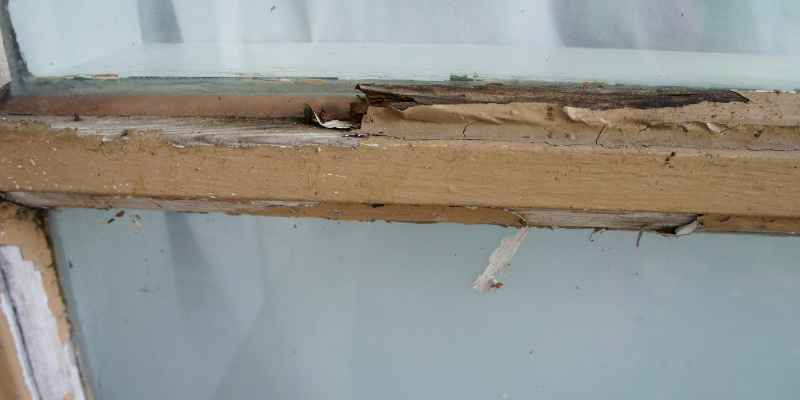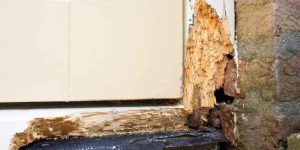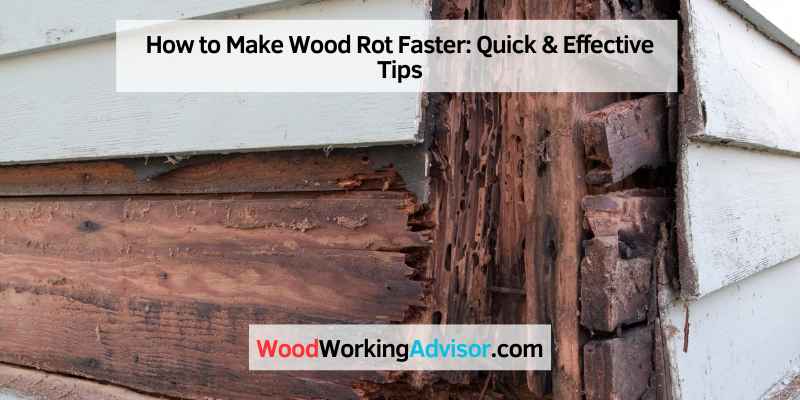To make wood rot faster, you can increase its exposure to moisture and fungi.
Introduction To Accelerated Wood Decay
Reasons For Speeding Up Rot
Several reasons may prompt the need to accelerate wood decay. Whether for research purposes or practical applications, expediting the deterioration process can be essential in various scenarios. Understanding the factors that contribute to rapid wood rot can provide valuable insights into both natural and human-induced decay mechanisms.
Safety Considerations
When expediting wood rot, safety considerations are paramount. Accelerating the decay process involves handling potentially hazardous materials and creating an environment conducive to microbial growth. It is crucial to adhere to proper safety protocols and utilize protective equipment to minimize health risks associated with accelerated wood decay experiments or applications.
Types Of Wood And Rot Susceptibility
Understanding the susceptibility of different types of wood to rot is crucial for various woodworking and construction projects. Let’s delve into the differences between hardwood and softwood, as well as the natural decay resistance of different woods.
Hardwood Vs Softwood
Hardwood and softwood possess distinct characteristics that influence their susceptibility to rot. Hardwood, derived from deciduous trees, tends to be denser and less permeable than softwood. On the other hand, softwood, obtained from coniferous trees, generally has a higher moisture content and is more susceptible to decay.
Natural Decay Resistance Of Different Woods
The natural decay resistance of various woods plays a significant role in their longevity. Some woods, such as teak and redwood, exhibit inherent resistance to decay due to their natural oils and extractives. In contrast, pine and cedar are more prone to rot, especially when exposed to moisture and environmental factors.
Moisture: The Catalyst Of Wood Rot
Moisture is the primary catalyst for wood rot, triggering the growth of fungi that break down the wood’s cellulose. Understanding how to manipulate moisture levels is crucial for accelerating the process of wood rot.
Maintaining High Humidity Levels
One effective method to expedite wood rot is by maintaining high humidity levels. This can be achieved by using a humidifier or by sealing the wood in a plastic bag to trap moisture.
Water Soaking Techniques
Another technique is water soaking, where the wood is submerged in water to saturate it. This accelerates the absorption of moisture, creating an ideal environment for fungal growth and wood decay.
Temperature’s Role In Wood Decay
Wood decay is influenced significantly by temperature. Understanding how temperature affects the decay process is crucial for accelerating wood rot. By controlling temperature levels, you can speed up the decay of wood materials. Let’s delve into the impact of temperature on wood decay and methods to optimize it.
Optimal Temperature Range For Rot
The ideal temperature range for wood rot is between 70°F to 90°F. Within this range, fungal activity increases, leading to faster decay. Extreme temperatures can slow down the decay process.
Methods To Increase Temperature
- Use heat lamps to raise the temperature around the wood.
- Cover the wood with a dark tarp to absorb more heat from the sun.
- Apply a heating pad directly to the wood surface for localized heating.
Oxygen And Its Effect On Decay
Accelerate wood decay by exposing it to oxygen, hastening the natural deterioration process. Oxygen fuels the growth of decay-causing fungi, breaking down wood at a faster rate. Introducing ample oxygen to wood can expedite its decomposition, making it a useful technique for certain applications.
Oxygen and Its Effect on Decay
Oxygen is essential for the survival of living organisms, but it can also cause decay and rot in wood. When wood is exposed to oxygen, it undergoes a process called oxidation, which breaks down the wood’s structural integrity and causes it to rot faster. In this section, we will discuss how oxygen affects decay in wood and ways to control it by ensuring proper air circulation and creating anaerobic environments.
Ensuring Proper Air Circulation
Proper air circulation is crucial for controlling the amount of oxygen that reaches the wood. When wood is exposed to stagnant air, oxygen accumulates, causing the wood to rot faster. To ensure proper air circulation, make sure that the wood is stored in a well-ventilated area. Avoid storing wood in damp areas or covering it with plastic, as this can trap moisture and prevent air from circulating. Additionally, make sure that there is enough space between the wood pieces to allow air to flow freely.
Creating Anaerobic Environments
Creating an anaerobic environment is another effective way to control wood decay caused by oxygen. Anaerobic environments are areas with little to no oxygen, which prevent oxidation and decay. One way to create an anaerobic environment is by submerging the wood in water. This method is commonly used for preserving wood for long periods, such as for underwater construction. Another way to create an anaerobic environment is by using airtight containers or wrapping the wood in impermeable materials like aluminum foil or wax paper.
Conclusion:
Controlling oxygen levels is crucial for preventing wood decay and rot. Ensuring proper air circulation and creating anaerobic environments are effective ways to limit the amount of oxygen that reaches the wood. By implementing these techniques, you can extend the life of your wooden structures and prevent costly repairs.
Biological Accelerators Of Rot
Decay fungi are primary agents in wood decomposition.
Bacteria and microorganisms aid in breaking down wood components.
Chemical Treatments To Induce Rot

To accelerate wood rot, chemical treatments can be used to induce the process faster. Substances such as borax, copper sulfate, and iron sulfate can be applied to the wood to expedite the decay. These treatments can help mimic natural decay processes and result in faster wood rot.
If you’re looking for a way to make wood rot faster, chemical treatments can do the trick. In this section, we’ll explore two types of chemical treatments: natural and household chemicals, and commercial wood rot accelerators.
Natural And Household Chemicals
There are a few natural and household chemicals that you can use to induce wood rot. Here are some of the most effective options:
- Vinegar: Soak a cloth in vinegar and wrap it around the wood. Leave it on for a few days to a week, depending on the desired level of rot.
- Bleach: Mix bleach with water and spray it onto the wood. Let it sit for a few days to a week, depending on the desired level of rot.
- Hydrogen peroxide: Mix hydrogen peroxide with water and spray it onto the wood. Leave it on for a few days to a week, depending on the desired level of rot.
- Borax: Mix borax with water and spray it onto the wood. Let it sit for a few days to a week, depending on the desired level of rot.
Commercial Wood Rot Accelerators
If you want a more powerful solution, there are commercial wood rot accelerators available. These products contain chemicals that speed up the rotting process. Here are some of the most popular options:
| Product Name | Active Ingredients |
|---|---|
| Wood Juice | Propylene glycol, copper naphthenate |
| Timber Pro UV | Copper-8-quinolinolate, zinc naphthenate |
| Boracare | Disodium octaborate tetrahydrate |
Before using any of these products, be sure to read the instructions carefully and follow all safety precautions. With the right chemical treatment, you can make wood rot faster and achieve the desired level of decay for your project.
Physical Interventions For Faster Decay
Accelerate wood decay with physical interventions such as moisture exposure and temperature control. By creating a damp environment and maintaining warmth, you can expedite the natural rotting process of wood. These methods can help speed up the decomposition of wood for various purposes.
If you’re looking for ways to make wood rot faster, physical interventions can be an effective solution. In this post, we’ll discuss two physical interventions that can accelerate the decay process: breaking down wood structure and applying mechanical damage.
Breaking Down Wood Structure
One way to speed up wood rot is to break down the wood structure. This can be achieved by using a hammer or mallet to create small holes or cracks in the wood. These openings allow moisture and air to penetrate the wood, creating an environment that is conducive to decay.
Another way to break down the wood structure is to use a drill to create larger holes in the wood. These holes can be filled with water or a decay-inducing solution to accelerate the rotting process. When creating holes, it’s important to space them out evenly to ensure that the entire piece of wood is affected.
Applying Mechanical Damage
Mechanical damage is another way to speed up wood rot. This involves physically damaging the wood to create openings for moisture and air to penetrate. Some common ways to apply mechanical damage include:
- Scratching the surface of the wood with a wire brush or sandpaper
- Breaking the wood with a hammer or mallet
- Chopping the wood with an axe or hatchet
When applying mechanical damage, it’s important to be careful not to damage the wood too much. If the wood is completely destroyed, it may not rot as quickly as intended.
In conclusion, physical interventions can be an effective way to make wood rot faster. Breaking down the wood structure and applying mechanical damage are two methods that can accelerate the decay process. By using these techniques, you can speed up the rotting process and create a more natural, rustic look for your wood projects.
Monitoring And Controlling The Decay Process
It is important to regularly monitor the wood to track decay progression.
Adjusting Conditions As Needed
Maintain optimal moisture levels to accelerate wood rot.
Environmental Impact And Disposal Of Rotted Wood
Accelerate wood decomposition by optimizing conditions like moisture and temperature. Enhance the rotting process for environmental disposal of wood waste. Promote faster wood decay through aeration and adding nitrogen-rich materials.
When it comes to disposing of rotted wood, the environmental impact should be a significant consideration. While it may be tempting to burn or bury the wood, it’s essential to choose safe and eco-friendly disposal methods to reduce the impact on the environment.
Eco-Friendly Practices
There are several eco-friendly practices you can adopt to dispose of rotted wood safely. One option is to use the wood as compost. By breaking down the wood, it can provide nutrients to the soil, making it an excellent fertilizer. Another option is to use the wood as mulch. Mulching can help retain moisture and suppress weed growth, making it a valuable addition to any garden.
Safe Disposal Methods
If you’re unable to use the rotted wood for compost or mulch, there are still safe disposal methods you can consider. One option is to take it to a landfill that accepts untreated wood waste. Some landfills have wood waste recycling programs, so it’s essential to check with your local landfill. Another option is to contact a wood waste recycling facility. These facilities specialize in recycling wood waste, so you can be sure that the wood will be disposed of safely and responsibly.
In conclusion, when disposing of rotted wood, it’s essential to consider the environmental impact and choose safe and eco-friendly disposal methods. By adopting eco-friendly practices and using safe disposal methods, you can help reduce the impact on the environment.
Conclusion: Balancing Speed And Safety
Balancing the need for speed with safety is crucial when attempting to accelerate wood rot. By following proper techniques and using suitable tools, you can effectively increase the rate of wood decay without compromising safety measures. Find the right balance to achieve faster results without compromising structural integrity.
Summary Of Techniques
Involving moisture, warmth, and fungi accelerates wood rot.
- Use high moisture levels and warmth.
- Introduce fungi or termites for decay.
- Consider using chemicals or borates.
Final Thoughts On Responsible Decay Acceleration
Balancing speed and safety is crucial for accelerating wood rot.
- Ensure proper safety measures.
- Monitor decay progress regularly.
- Be cautious with chemical accelerators.

Frequently Asked Questions
How Can I Accelerate Wood Rotting Process?
To speed up wood rot, increase moisture and use a rot-promoting solution like iron sulfate. Ensure proper ventilation for fungi growth.
What Factors Enhance Wood Decay?
Humidity, temperature, fungi presence, and wood moisture content are key factors that influence wood decay process.
Is Wood Rot Essential For Ecosystem Balance?
Yes, wood rot is crucial for nutrient recycling in ecosystems. It breaks down dead wood, returning nutrients to the soil.
How To Identify Wood Rot In Structures?
Look for soft, spongy wood, musty smell, and discoloration. Probe with a screwdriver to check for structural integrity. Consult a professional if unsure.
Conclusion
To summarize, accelerating wood rot can be achieved by following these simple steps. Firstly, ensure the wood is exposed to moisture and humidity consistently. Secondly, create an environment conducive to fungal growth by keeping the wood in damp conditions. Thirdly, introduce wood decay fungi or use commercially available products to speed up the rotting process.
Remember, always exercise caution and safety measures when working with rotting wood. With these techniques, you can expedite the natural decay of wood for various purposes. Happy wood rotting!


